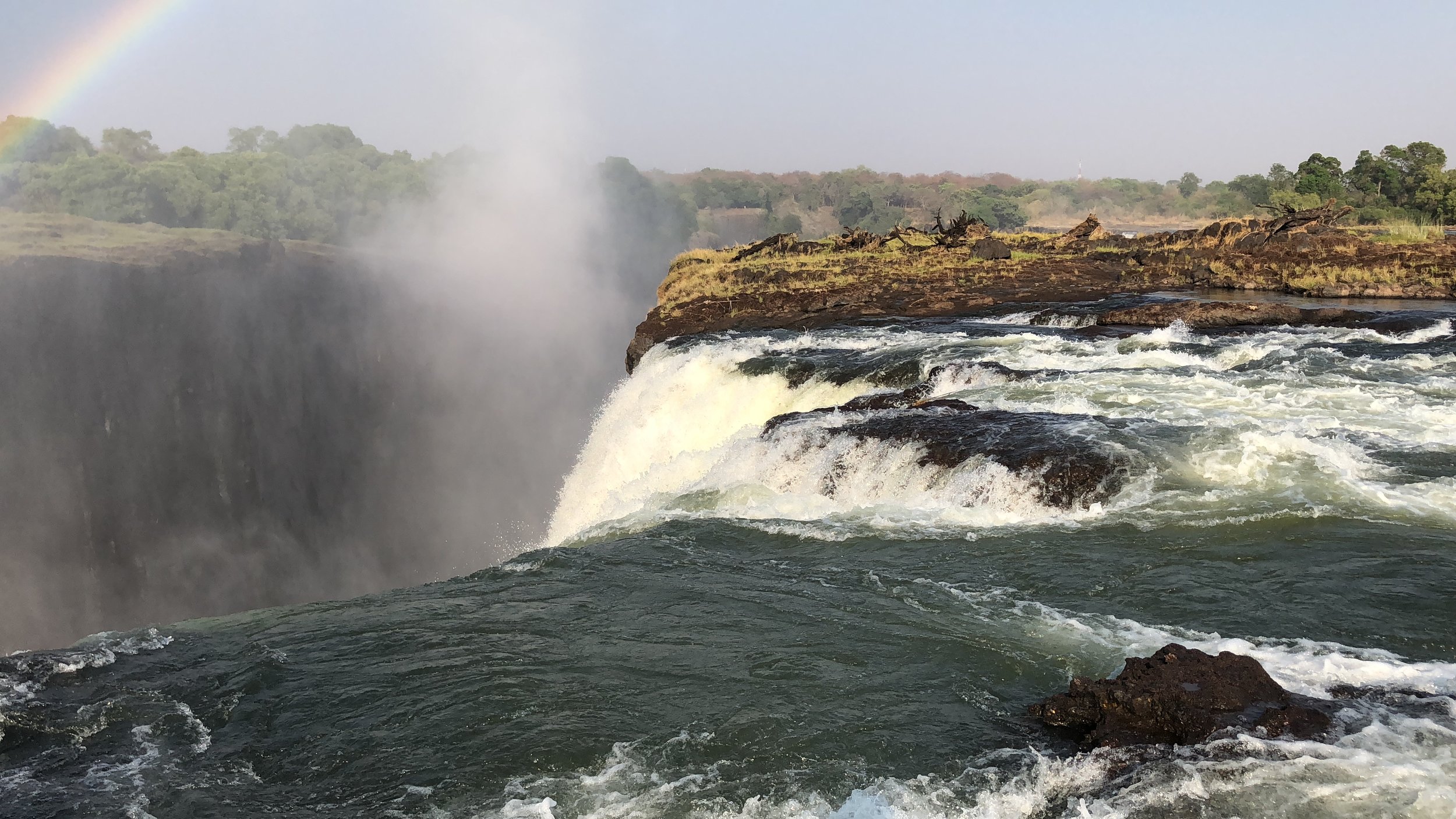After flowing south for thousands of miles from the highlands of Angola, the Zambezi River flings itself exuberantly off a 350-foot-tall cliff, forming the magnificent Victoria Falls. Known for millennia to the local people as “the smoke that thunders,” it was named for Queen Victoria by the explorer David Livingstone, believed to be the first European to visit the falls, in 1855. Like Niagra Falls in North America and Iguazu in South America, Victoria Falls is locates on the border of Zambia and Zimbabwe. While it is not the tallest waterfall in the world (that’s Angel Falls in Venezuela) or the widest waterfall (which is Iguazu), the combination of its impressive height and breadth means that, in the wet season, a larger sheet of falling water spills over it than any other waterfall in the world.
The falls can be visited and viewed from either Zimbabwe or Zambia. You can even do a border crossing (visa fees may apply) to see it from both sides in a single day.
This is the dry season - in the wet season, this would be a solid sheet of water
The views of the falls are generally considered to be more spectacular from the Zimbabwe side. A small National Park near the cross-border bridge offers visitors a series of 12 viewpoints stretched along a 1-km paved path. The views vary dramatically depending on the time of year. In the wet season, the pour of water is torrential, with billowing clouds of soaking mist. In the dry season (when I visited), it becomes more of a series of separate waterfalls. It’s still dramatic and gorgeous, with plenty of mist and early-morning rainbows. And visiting in the dry season offers people an opportunity that wouldn’t be feasible in wet season: the Devil’s Pool.
In the dry season, when the level of water over the falls drops, a shallow pool protected by a low lip of stone emerges from the falls. This is the Devil’s Pool, and because TIA (“this is Africa” - a phrase that gets thrown around a lot around here) you can go for a swim in it.
view of people in The Devil’s Pool has n Zambia from the Zimbabwe side of the falls
view of the falls from the Devil’s Pool
The pool is accessed from the grounds of the Livingston Hotel, on the Zambia side of the falls. A 5-minute boat ride down the river towards the falls brings your group to Livingston Island. That’s where you meet up with your guide and your photographer. The photographer will take one or two phones or cameras and take photos to be shared among the group. On the island, you can change into your bathing suit (and your water shoes, if you have them). There is a short walk along the edge of the falls, then a short swim in the river, then a scramble down a few ragged rocks and suddenly the current is pushing you against the lip of stone as you stare over the edge of the falls and contemplate your own mortality.
Here we are, a heartbeat away from death
It is absolutely one of the most terrifying, absurdly risky things I’ve ever done. Our guide jumped from the rocks into the pool to show us how safe it was, and it made me sick to my stomach to watch him do so. I oozed down the rocks, maintaining at least 3 points of contact at all times, and my heart was still pounding the whole time. I don’t regret it for a second, but I’d never do it again.
This is not a smile - it is a rictus of terror twisting up my face
Our photographer put us through a series of group and solo poses, then we did the trip in reverse: scramble up the rock, swim the river and then walk the edge back to Livingstone Island for a light breakfast, then the boat drops you off back at the Livingston Hotel. The entire process took less than 2 hours, but it felt more like 6. We treated ourselves to a celebratory mimosa poolside while we recovered from the adrenaline rush.
View of my group in the Devil’s Pool, taken across the ravine by a far more sensible friend who stayed on dry land - thanks, Adam!
If you go: Victoria Falls Park (on the Zimbabwe side) opens at 6am and it costs $30 per visit. If you leave, you have to pay again to re-enter. Early morning gives you the best chance for rainbows over the falls, especially around viewpoints #9-12.
The falls can be visited in any season, but if you want to visit the Devil’s Pool you need to time your visit to the dry season. Advanced reservations for the Devil’s Pools excursion are strongly encouraged. We chose the 7:30am time slot because the earlier you go, the better the rainbows are. We hired 2 cabs to take us there: one drove us from our Zimbabwe hotel to the Zimbabwe immigration office, then a second cab picked us up at Zimbabwe immigration, drove us across the bridge between the two border posts, facilitated obtaining the Zambia day-visa at Zambian immigration and then drove us to the Livingston hotel. When we were done, we did the same trip in reverse. The cabs cost about $15 per person round-trip ($5 for the zimbabwe part, $10 for the Zambian part.). You could easily walk instead, but it would be several hot dusty miles. The Zambia day-visa costs $20 per person. Be sure you have a double-entry Zimbabwe visa, or you’ll have to pay for another Zimbabwe visa when you return to Zimbabwe.











